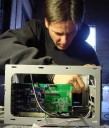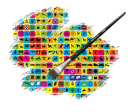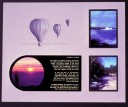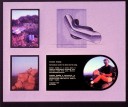The Ultimate Camping Subaru
- Date: 2016
- Motive / Client: This 2000 Subaru Forester needed an upgrade.
- Overview: A self-contained, solar powered A/C power source for weekend getaways. Want solar powered A/C for to charge your laptop, mobile phone, and power tools? It’s not easy, but you can add a 100W solar panel, charge controller, battery, and high wattage inverter to your car.
Learn more from this photo essay …
P9K0
- Date: 2010
- Motive / Client:
- Overview: A low-cost, fully mechanical study of human motion in the hips and legs. Initiated in the fall of 2010, the prototype “walker” was used to gauge the torque required to lift the limbs, and to determine the minimal number of joints required to simulate human motion over smooth terrain.
iConji
- Date: 2009-2011
- Motive / Client: iConji is a digital, pictograph-based system for international communication.
- Overview: Born of my desire to develop a simple, fun-to-use universal means of communicating in a digital world which brings people to understand each other in a new way. While increasingly functional each year, automated translators reside in the middle, parsing phrases from speaker to recipient. With iConji communication is direct. While simple in form, the speaker must consider the means by which the message is generated, thereby connecting her own frame of mind with that of the recipient. In the end, iConji is not designed to replace Google’s Translate nor learning a new language, but it is fun to use, beautiful to behold, and often quite humorous along the way.
In the process of developing the iConji applications with my team, we created 1,200 characters. So engrossed was I in this new way of thinking that as I was speaking with someone, I saw iConji characters flying across my field of view. Graphical symbols became part of my thought process. During the year of principal development, I read every book I could find on the history of human communication, symbols, myths, and the evolution of the human brain to support vocalization of our emotions and transmission of information. It was a wonderful, educational journey for all those involved.
SketchBox
- Date: 2006-2010
- Motive / Client: Terra Soft Solutions
 Overview: The patented SketchBox concept was born in the year that MIT’s Nicholas Negroponte initiated the concept for a small, highly portable, durable and inexpensive tablet computer for children in underdeveloped countries. I had already been studying the evolution of personal computers and PDAs and how they were received in both domestic and international markets, and recognised a gap in existing and reported product trends.
Overview: The patented SketchBox concept was born in the year that MIT’s Nicholas Negroponte initiated the concept for a small, highly portable, durable and inexpensive tablet computer for children in underdeveloped countries. I had already been studying the evolution of personal computers and PDAs and how they were received in both domestic and international markets, and recognised a gap in existing and reported product trends.
I developed a series of sketches, 3D model (made of wood, glass, and some twenty coats of auto paint), and working prototype which went on tour to Japan, India, Singapore, and the Philippines.

Yellow Dog Linux
- Date: 1999-2008
- Motive / Client: Terra Soft Solutions
- Overview: In 1998 my business partner Dan Burcaw and I launched Terra Soft Solutions and its chief product, Yellow Dog Linux. The next ten years were spent developing software product lines: the YDL operating system; Y-Bio for bioinformatics, Y-FILM for VFX task management with Circle-S Studios, and the highly scalable Y-HPC node construction and management suite; services, marketing, and customer support.
Yellow Dog Linux was heralded as the simplest to install and easiest to use desktop Linux OS of its era, as made evident by the customer feedback. During my decade as CEO, my rag-tag team of can-do engineers and creative types maintained a regular deployment of industry firsts, including development of yup (Yellowdog UPdate) which became the foundation for yum (Yellowdog Update Modified), the industry standard for Red Hat’s RPM manager.
Learn more …
RB5X, Jr.
- Date: 1995-1997
- Motive / Client: Terra Firma Design for General Robotics Corporation
- Overview: The RB5X, Jr. was a fully functional robot built from the parts of the full scale RB5X. The intent was to reduce the cost of manufacturing while maintaining the core functions, even improving the versatility over the primary product: mobility, touch sensors, ultrasound, infrared, on-board navigation computer and voice synthesis. All were maintained through reorganization of the primary motherboard into a horizontal, more compact configuration.
Structural Defect Detector
- Date: 1995-1997
- Motive / Client: Terra Firma Design for RLE Technologies
- Overview: I developed concept drawings for a hand-held or vehicle-mounted tool which through the use of reflected,low-power microwaves could detect otherwise invisible defects and cracks in the concrete structure of bridges and buildings.
Hot Knife, Cutting Machine
- Date: 1995-1997
- Motive / Client: Terra Firma Design for Colorado Clean Room Company
- Overview: Two simple improvements to two old tools: a hot-knife and bed combination enabled more rapid, accurate cutting of tubular webbing in a mass production environment; a reciprocating saw coupled with a rapid-clamp bed enabled more rapid cutting of many layers of large fabrics.
R Factor E Sleeping Pads
- Date: 1995-1997
- Motive / Client: My passion for the out-of-doors; personal project
- Overview: This “R Factor E” brand product was developed to a fully functional, prototype. These backpacking sleeping pads incorporated internal, dual-layer insulation: open-cell foam and industrial aluminum-sided bubble pack. The foam provided comfort while the bubble pack doubled as a reflector to signal for help. Reinforced tubular webbing around the outside edges and across the middle coupled with heavy duty grommets enabled this pad to be used as a gurney, hammock, or chair. Under non-disclosure agreement REI’s “Dirty Dozen” tested the product for two weeks in the Washington Cascades. However, I later made the mistake of sending two prototypes to Easter Mountain Sports later that same year, only to threaten legal action in order to get them back again, six months later. The next season, Easter Mountain Sports sold a product line which matched my design nearly perfectly, including the multiple colored bands of fabric, webbing and grommets. Lesson learned.
Ergonomic Keyboard
- Date: 1993
- Motive / Client: Arizona State University, Industrial Design
- Overview: A split, ergonomic keyboard and mouse combination. Hand-fabricated from acrylic, styrene, and some functional parts (track ball and enclosure) taken from a mouse. To learn more, visit the Patents page.
R Factor E Bandanas
- Date: 1991-1993
- Motive / Client: Desire to bring my own product to market.
- Overview: This “R Factor E” brand product line was built upon the concept of a reversible fabric bandana, colorful and inviting on one side, silver and reflective on the other. Wear the silver side out to reflect the sun on hot, summer days; facing in when you desire to conserve heat. Locally hand-sewn, I produced over one hundred units which were sold in two Phoenix retail stores.
Care Wagon
- Date: 1991-1993
- Motive / Client: Arizona State University, Industrial Design / St. Joe’s Children’s Hospital
- Overview: As part of my Industrial Design program at ASU, I worked with St. Joe’s to design an improved means by which children could be moved between rooms with reduced chance of untethering their IV pole. I designed a side-mount treatment for their red wagons which enabled each child patient to customize, using crayons or dry erase markers, their transport. I built a prototype of an IV pole attachment system using off-the-shelf parts from the local hardware store, freeing the attendant to worry only about looking ahead as he or she navigated the hospital hallways.
DisClosure
- Date: 1991-1993
- Motive / Client: Arizona State University, Industrial Design
- Overview: An alternative to the traditional, spring-loaded tongue/grove and deadbolt door closure system. This design concept remains valid and worthy of pursuit in the market place.
Backpacking Solar Oven
- Date: 1991-1993
- Motive / Client: Arizona State University, Industrial Design
- Overview: In just minutes, you can unroll and setup this highly portable solar oven. Its altazimuth design allows for one corner of the unit to act as an east to west pivot while the sun may be tracked on the vertical axis by means of tension in the support lines. It was a great idea, but had a hard time warming butter let alone baking a chicken. Worked great as a tanning bed or emergency beacon.
Face Shield
- Date: 1991-1993
- Motive / Client: Arizona State University, Industrial Design / Xylem Design
- Overview: Light, soft, and highly comfortable, these prototype protective masks proved highly functional in a real-world test. The shields were snapped into place, allowing for different configurations and easy replacement if scratched over time.
Biofeedback in Virtual Reality
- Date: 1991-1993
- Motive / Client: Arizona State University, Industrial Design
- Overview: This conceptual, stress relief and meditation system incorporated biofeedback into virtual reality. At first, the system leads the user into a state of relaxation, matching the movement of hot air balloons or waves on a beach to the user’s heart beat, galvanic skin response, and breathing. But once mastered, the user may take control and modify the virtual environment for a full interactive environment. While not a fully functional system, the goggles were built around eye pieces taken from video cameras and the galvanic response monitor did in fact function, providing audio feedback based upon the electrical conductivity of the skin.
Stream Keys
- Date: 1993
- Motive / Client: Arizona State University, Deep Creek School, Graduate Art Program
- Overview: As part of a one month graduate level art program, I designed and built a simple robot which literally played its own music, motivated by Deep Creek, just downstream from Telluride, Colorado. Eight toilet bowl floats bobbed in the water, triggering electrical switches which in turn caused doorbell solenoids to fire and play the keys on a MIDI keyboard. The music was astounding, sometimes without apparent rythm, and yet, over time, a pattern emerged from morning to night, when the water level rose and fell with the change in temperature of the days.
Musical Instruments
- Date: 1992
- Motive / Client: ASU, Industrial Design, Jr. Year Internship; Ithaca Science Center
- Overview: I conducted my Junior Year, summer internship working for Robert Leathers Associates of Ithaca, New York. During this summer, I was fortunate to also work with the Ithaca Science Center where I designed outdoor musical instruments for their new playground and learning space. The wooden keyboard was designed to be mounted on a railing such that it could be played with a light mallet in its upright position, or flipped over to be played as a keyboard.
Water Flow, Interactive Exibit
- Date: 1992
- Motive / Client: ASU, Industrial Design, Jr. Year Internship; Ithaca Science Center
- Overview: I conducted my Junior Year, summer internship working for Robert Leathers Associates of Ithaca, New York. I was fortunate to meet Tom Rockwell who invited me to assist him with the design and configuration of an interactive water exhibit for the Ithaca Science Center. Tom is now the Director of Exhibits for the Exploratorium in San Francisco, California.
Wave Propagation, Interactive Exhibit
- Date: 1992
- Motive / Client: ASU, Industrial Design, Jr. Year Internship; Ithaca Science Center
- Overview: I conducted my Junior Year, summer internship working for Robert Leathers Associates of Ithaca, New York. During this summer, I was fortunate to also work with the Ithaca Science Center where I designed interactive science center exhibits. This one is a simple means of demonstrating wave propagation by use of opposing magnets suspended across parallel bars. The low friction environment enabled long play, and even the occasional constructive wave development which tossed the last magnet off the end.
Peggy’s Plane
- Date: 1992 (?)
- Motive / Client: Peggy Thomas
- Overview: Inventor-Entrepreneur Greg Glebe and I modified this powered parachute for Peggy, a woman who loss the use of her legs and arms following a car wreck. Determined to fly an airplane, she asked Greg and me to modify a powered parachute in order that she could fly solo. Greg was a master of pneumatics and I had experience in electrical wiring. Together, we were successful and on a cool morning in the desert northwest of Phoenix, Arizona, Peggy took off, flew for ten minutes, and landed safely again–solo. That morning yet holds one of the greatest moments of my life.
Peggy’s Plane was featured in a Phoenix NewTimes article: part 1 and part 2.
LandAir Flying Car
- Date: 1992
- Motive / Client: Greg Glebe
- Overview: Inventor-Entrepreneur Greg Glebe built the LandAir flying car literally from the top down, hanging the very first aluminum strut from the ceiling of his woodshop in Phoenix, Arizona. He then added each structural member of this unique, 2-seater powered parachute until he had a vehicle capable of 60MPH on the ground and altitudes of greater than 10,000 feet. Over the course of a few years, the LandAire saw improvements which included a water-cooled, 4-stroke engine, hand-ratchet which altered the shape of the airfoil to increase or decrease the forward velocity, and hydraulic disc brakes. Yes, it was licensed by the Arizona DOT.
My work on the LandAir included electrical wiring, some mechanical improvements, and test flights when Greg’s dog Wiley was not up to the challenge.
The LandAir made the 10 o’clock news with Dan Davis and the front page of the Phoenix NewTimes.
Bird Feeders
- Date: 1989 (?)
- Motive / Client: Desire to bring my own product to market.
- Overview: While working at Xylem Design, I was inspired by owner / entrepreneur Greg Glebe to give a go at small-scale production of my own invention. I researched, built prototypes, and tested a variety of easily mass-produced bird feeders. There were (if I recall correctly) four designs in all, each intended to attract and support a different kind of bird found in the Arizona Sonoran desert. I was successful in building some thirty units and selling them through a local store.
A House Miniature
- Date: 1989
- Motive / Client: A passion for detail; a neighbor with money.
- Overview: Not an invention, but a really enjoyable project–the neighbor across the street from where I lived in Phoenix asked me to build a scale replica of the house in which they lived, for their daughter, in order that she could have a doll house that reminder her of where she was lived as a young girl. I cut more than 100 feet of 1/4 inch strips in order to create the laminated oak floor.









































